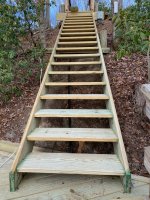s219
Super Member
- Joined
- Dec 7, 2011
- Messages
- 8,548
- Location
- Virginia USA
- Tractor
- Kubota L3200, Deere X380, Kubota RTV-X
This assumes you have a "good" lumberyard nearby. I don't know of any near me. The wood at the independent home centers doesn't seem to be any better than what Lowes, HD, etc. have, and it's more expensive.
The only difference is that it's easier to find someone to help you load/pick if you need it.
I was at a builder supply last week ordering pine siding for my barn and asked about their pricing on treated lumber. They wanted $24 for a #1 grade 2x12-12' ground-contact and it's from a treating company about 50 miles away that has a good reputation. Free delivery. We had used them when building out house and all that lumber is still holding up well (even stairs made with this same exact design). Lowes wants $20 for a #2 board of the same size, from who knows where and I can vouch that the treatment isn't always consistent. For an extra $4 it was a no brainer to order from the builder supply and get a better grade board and free delivery. Hopefully the treatment quality is as good as their past product. So far it looks good when I saw into it.

